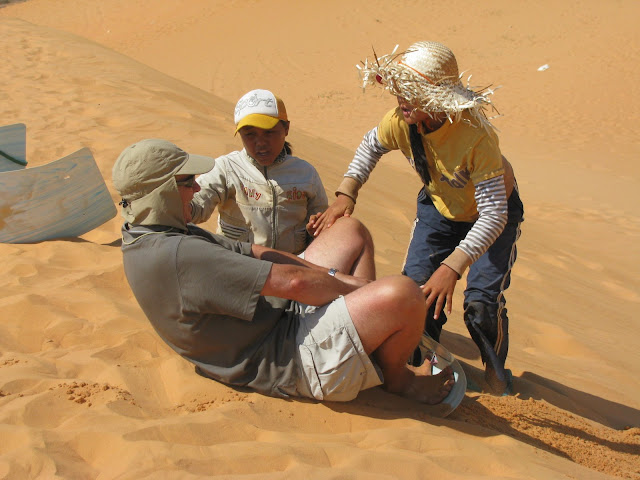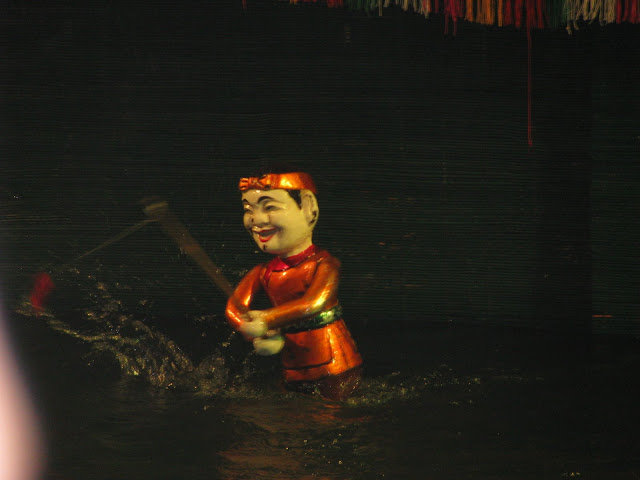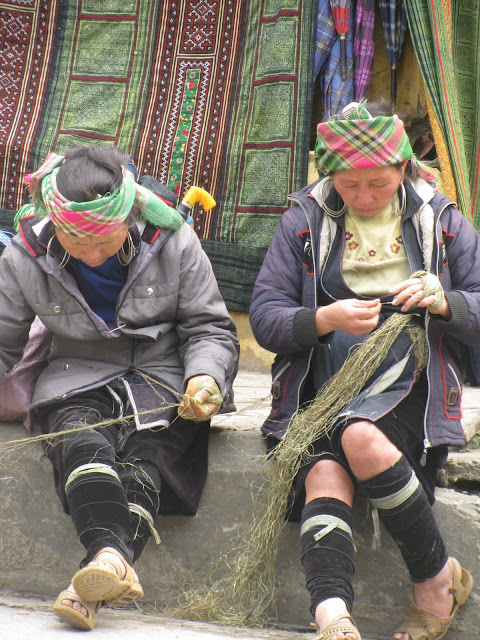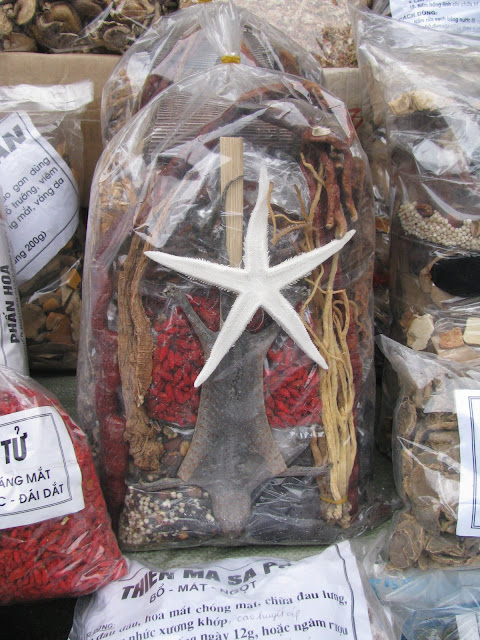After a four hour bus ride from Saigon we arrive for some beach time in the picturesque fishing village of Mui Ne, one of the best laid-back getaways in Vietnam.
Traditional fishing boats are round and we wonder how the locals can tell the bow from the stern. Tim thought they resembled the old-fashioned coracles from Wales.
A short distance from Mui Ne are the Red Dunes. A couple of friendly girls convince apprehensive Tim to rent a plastic sled for a ride down the steep dunes. Sandi went too but moved so fast she couldn't be caught on camera. Weeeee!!!... and there he goooooes...
North to the beach town of Nha Trang, Vietnam’s premiere diving locale, where we don scuba gear for two dives to see amazing colourful coral and reef fish around the small islands offshore.
Vietnam's coastline runs 1700 long kilometers so we opted for a short one hour flight in preference to the 11 hour overnight bus to the Unesco World Heritage Site of the historic town of Hoi An. Here's Sandi (in green hat) on the famous Japanese covered bridge built in the 1600s.
From the 16th to 18th centuries the small town of Hoi An was Vietnam’s most important port and trading post particularly for ceramics with nearby China. Today it's a quaint town with some 844 structures protected as historic landmarks which show the unique influence of Chinese, Japanese and French traders who passed through or settled here.
We wander among historic homes and temples, admire the beautiful architecture, lounge in open air cafes and gaze at the exotic foods in the market.
Hoi An is famous for colourful, silk lanterns which light up the streets.
Wanting to get a little further afield but not having the heart to disturb the sleepy cycle rickshaw drivers...
From Hoi An a three-hour bus ride brings us to Hue, once Vietnam's imperial city, the capital of the country from 1802-1945. We hire a cycle rickshaw to take us to see the Citadel and village life on the outside the old city walls. Tragically, most of the Citadel was completely decimated during the French and American wars. Still, there is much to see. There’s always time for romance so we pause for a kiss in front of one of the gates of the old city.
Outside the city, set like royal crowns on the banks of the Perfume River are the Tombs of the Nguyen Dynasty. Altogether there were 13 kings. As befits an emperor, all have tombs of significant size, some as large as a small town.
Tim strikes a pose at the tomb Minh Mang.
The Phuoc Dien Tower stands in front of the Thien Mu Pagoda. Each of the seven tiers is said to represent the seven steps towards Buddhist enlightenment.
Hoa Lu, the capital of Vietnam from 968 to 1010, is located in a valley surrounded by awesome limestone formations which jut out of the rice paddies. Most of what remains of the kingdom are ruins but there are still ancient temples in the valley that were renovated in the 17th century. Here’s an inside peek of the alter of one, joss sticks a-smokin’.
We cycle a village path to nearby Tam Coc passing rice paddies, wallowing water buffalo and limestone outcrops.
Aboard a small sampan we are rowed by two small women down a lazy river as the skies open and we are flooded in rain. Wisely, we bought a $2 umbrella and plastic rain coverings at the lunch stop shop before we set off.
Welcome to Hanoi, where the exotic chic of old Asia blends seamlessly with the dynamic face of new Asia—a city with a quixotic blend of Parisian grace and Asian pace, an architectural museum piece evolving in harmony with its history. Tim was hassled by this cute Canadian-looking woman selling fruit and promised to buy ‘maybe tomorrow’.
In the heart of Hanoi the famous red bridge on Hoan Kiem Lake leads to the Ngoc Son Temple which houses the remains of a gigantic tortoise believed to have weighed over 200 kilograms. The species is said to still inhabit the lake.
This loving couple was getting their wedding photos taken so Sandi snuck in to capture the moment too.
Water puppetry is a fascinating ancient, art form that originated in the rice paddies in northern Vietnam and Hanoi is the best place to catch a show. The puppets are attached to invisible, underwater bamboo poles and manipulated by puppeteers from behind a curtain. Very cute and clever—a fun time not to be missed.
Majestic and mysterious, inspiring and imperious, words alone cannot do justice to the natural wonder that is Halong Bay, where more than 3000 incredible islands rise from the emerald waters of the Gulf of Tonkin. It is pure art, a priceless collection of unfinished sculptures hewn from the hand of nature. We cruise the karsts from the deck of a junk (like the ones in these photos) as the sun sinks into the horizon.
Majestic and mysterious, inspiring and imperious, words alone cannot do justice to the natural wonder that is Halong Bay, where more than 3000 incredible islands rise from the emerald waters of the Gulf of Tonkin. It is pure art, a priceless collection of unfinished sculptures hewn from the hand of nature. We cruise the karsts from the deck of a junk (like the ones in these photos) as the sun sinks into the horizon.
After spending the night on the junk the next morning we sail to a large island and wander through a glorious, huge cave.
Being rowed through the karsts tourist-style.
The Queen of the Mountains, Sapa sits regally overlooking a beautiful valley, with lofty mountains towering over the town on all sides. Sapa was discovered by French missionaries in 1860, and later became a holiday escape for French colonists and eventually opened up for tourism in the 1990s. The whole area is spectacular and frequently shrouded in mist as it was for us as we wandered along the rice paddies. Hill tribe people from surrounding villages don their most colourful costumes and head to town daily.
A farmer ploughs rice terraces with his trusty water buffalo.
Daily life in Sapa town mixes motorbikes, water buffalo and hill tribe people selling their wares.
Tribeswomen sit and stitch beautiful embroidery all day in the streets. It is a chance for them to get together with friends for a good chat and sell a few of their hand-made articles to the tourists.
These women from a different tribe wear bright coloured, hand-woven, checkered head scarfs and ornate jewellery.
Two, tiny local women befriend Sandi making her 5' 3", size zero look not so tiny.
We notice bags like this being sold all over town and wonder what they are used for—full of dried ingredients, most of which we don't recognize except for dried bark, peppercorn, roots, chili, starfish and a nasty-looking bat. Sandi thought they were for simmering into a nutritious, aphrodisiacal soup but our guide later informs us they are to put in a hot bath to cure all sorts of ailments. We'll stick with Hermès an Jo Malone bath products, thank you very much.
Vietnam was a feast for all the senses. Thank you Uncle Ho—we had a great time! We're off to the city of Kunming, capital of China’s Yunnan Province.















































No comments:
Post a Comment